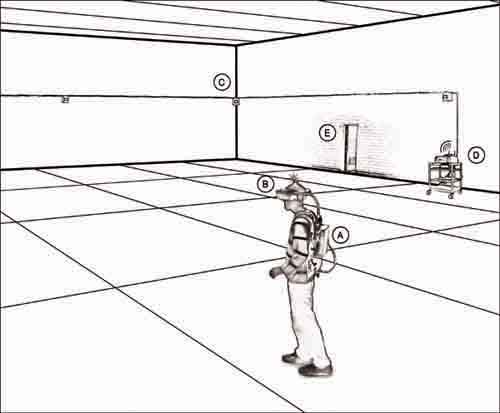System Description
The HIVE is composed of several major sub-systems and components as depicted in Figure 1 below:

Figure 1: Huge Immersive Virtual Environment System.
- A wearable rendering system
- A head-mounted display and orientation tracking device
- Twelve infrared cameras
- A position processing system
- A control room for monitoring the VE state.
Current system

Figure 2: The wearable rendering system
A) Wearable Rendering System
Users of the HIVE are completely un-tethered and encumbered as little
as possible. HIVE users carry a portable rendering unit, orientation
sensor for head-tracking, a custom-built video control unit for
the HMD, and associated power supplies. The rendering computer,
video control unit (VCU), and power supplies are mounted to a small
backpack frame (see Figure 2 to the right). The total weight of the
backpack with a single battery for HMD power is approximately 9.8
kilograms.
B) Head Mounted Display (HMD) and Orientation Tracker
Immersion in the HIVE is achieved by
presenting computer generated images to participants in an NVIS
nVisor SX HMD. The unit is a light weight (1 kg), dual VGA frame-parallel
HMD. The HMD has a stereo display with a resolution of 1024 x 1280 for
each eye. Field of view is approximately 60° diagonal and 48° horizontal
with an angular resolution is 2.25 arc minutes per pixel. Overlap between
the displays is 100%. The dual reflective FLCOS (Ferroelectric Liquid-crystal-on-Silicon)
displays produce 24 bit true color with a contrast ratio of 200:1. Head
phones with frequency response ranging from 15 to 25,000 Hz are integrated
into the unit. Correct synch information and voltage must be supplied
to the HMD through a stereo video control unit (VCU).
C) Twelve Infrared Cameras
In general, optical
position tracking using triangulation can operate over longer distances
with less interference than alternative tracking technologies. HIVE
cameras (Figure 3) work optimally in cool ambient lighting (e.g., fluorescent,
mercury vapor lights, and sodium vapor lights). The use of twelve
cameras facilitates coverage of the large tracking area, increases
precision, and reduces possible problems related to occlusions.

Figure 3: A HIVE camera
D) Position Processing System
The HIVE uses the infrared Precision
Position Tracker (PPT X8) manufactured by WorldViz, LLC. It is capable
of tracking the position of up to eight markers (infrared LEDs emitting
light at 880 nm) simultaneously. The system updates position at 60 Hz;
the manufacturer indicates that the total latency for the tracker (including
RS232 communication) is 20 ms. For measurements within five meters of
the center of the HIVE, position tracking error averages 2.09 cm ± .005
(for a 95% confidence interval). 80% of the tracking area has an absolute
measurement error less than 7.49 cm, and overall RMS error is 6.68 cm.
Variability in postition estimates averages 0.44 cm ± .28 (for a 95% confidence
interval). 80% of the tracking area has a variability in position estimation
of less than 0.63 cm.
E) Control Room
The rendering and position-tracking computers
are controlled and monitored through a graphics workstation. This workstation
provides remote access to the computer worn by the user as well as to
another workstation dedicated to the position tracking system. It enables
researchers to monitor the visualizations that are displayed in the
user's HMD. The HIVE software supports monitoring by creating a cluster-based
network. This allows multiple viewpoints of a single virtual simulation
to be rendered across more than one computer. Low-level synchronization
of the VE state across machines is handled automatically over the Local Area Network via
UDP packets.
System Software
Currently, we use Unity 3D to support the HIVE. Unity provides a basic framework for quickly constructing real time 3D computer-simulated environments. With support for most standard 3D model and texture formats, visual content can be easily developed with third party modeling programs.
HIVE researchers have implemented a HIVE application programming interface (API). The primary purpose of this API is to standardize the way software interfaces with the various input devices of the HIVE and to speed the implementation of research and other applications of the HIVE. The standardization further speeds development of virtual worlds to provide specialized functions that support experimental work conducted in the HIVE.
Coming Soon
- XSens MOVEN inertial body tracking
- Multi-user support


